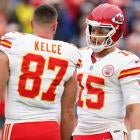For better or worse, free agency gives a player an accurate barometer of his actual value. The open market has spoken on Le'Veon Bell, who sat out the 2018 season rather than make $14.544 million playing under a franchise tag for a second-straight year.
The three-time All-Pro running back signed a four-year, $52.5 million contract with the Jets. The deal has a veteran running back contract record $27 million fully guaranteed at signing. There are $35 million in overall guarantees. Incentives and salary escalators make the maximum value of the deal $60.15 million.
Bell had repeatedly said during the two years in which he was designated as a franchise player by the Steelers, 2017 and 2018, he wanted to fundamentally change how running backs are compensated. He had suggested that he should be paid like a No. 1 running back and a No. 2 wide receiver because of his dual threat capabilities.
Nonetheless, Bell, who recently turned 27, further solidifies a running back market that had been in steady decline before the Rams gave Todd Gurley a four-year, $57.5 million extension (worth a maximum of $60 million through salary escalators) last July. David Johnson's three-year, $39 million extension containing $31,882,500 of guarantees hours before the Cardinals' 2018 regular season opener was evidence that Gurley's contract wasn't an anomaly. The deal is worth up to $45 million with incentives.
The following chart compares Bell's new deal to Gurley and Johnson's extensions in a few key contract metrics.
| Total guarantee | Fully guaranteed | Signing bonus | 3-year cash flow | First 3 new years | Avg. per year | |
|---|---|---|---|---|---|---|
Le'Veon Bell | $35,000,000 | $27,000,000 | $8,000,000 | $39,500,000 | $39,500,000 | $13,125,000 |
Todd Gurley | $45,000,000 | $21,950,000 | $21,000,000 | $40,000,000 | $47,050,022 | $14,375,000 |
David Johnson | $31,882,500 | $24,682,500 | $12,000,000 | $31,882,500 | $39,000,000 | $13,000,000 |
A couple of the metrics warrant an explanation. Professionals within the industry (agents and team negotiators) typically value deals by new money, which is the amount of compensation in a contract excluding what a player was scheduled to make before receiving a new deal. For example, Gurley had two years left on his contract totaling $ 11,949,978 when he received his new deal. Although he signed a six-year contract for $69,449,978, it's considered as a four-year, $57.5 million extension with a new money average of $14.375 million per year among industry professionals. Gurley's remaining contract years are subtracted from the $69,449,978 six-year total to arrive at this number.
Compensation in the first three new years is the amount of money in a contract exclusive of what a player was scheduled to make before receiving a new deal, just like with new money when determining average yearly salary. The cash flow analysis looks at the compensation in its totality. The focus is on the amount of money received in the first three years of a contract, regardless of whether it's considered as new money. Both metrics have the same dollar amount when a player signs a new contract as a free agent or when his contract is set to expire.
Each deal gives the running backs the ability to earn additional money based on performance. Gurley's 2023 base salary can increase by a maximum of $2.5 million. Rushing for at least 1,200 rushing yards or 1,650 yards from scrimmage (combined rushing and receiving yards) with the Rams making the playoffs in the same year once during the 2018 through 2022 seasons raises Gurley's 2023 base salary by $1 million. Accomplishing the feat twice makes the escalation $1.75 million instead of $1 million. Doing it on three separate occasions would bring the total increase to the $2.5 million limit.
Gurley has another way trigger the increase. Being named the NFL's Offensive Player of the Year, which Gurley was in 2017, or league MVP by either the Associated Press or Pro Football Writers of America once during the 2018 through 2022 seasons is worth $1.25 million. Winning awards in two different seasons would get Gurley the maximum $2.5 million raise.
The escalation is capped at $2.5 million regardless of how many of the milestones Gurley achieves. Gurley gaining 1,251 yards on the ground and amassing 1,831 yards from scrimmage last season has increased his 2023 base salary by $1 million.
Bell has $1.5 million in annual incentives. He earns $500,000 for at least 1,800 yards from scrimmage. He gets additional $500,000 by reaching 2,000 scrimmage yards. There's another $500,000 for the first threshold with the Jets making the playoffs.
Bell also has a $550,000 base salary escalator in each of the last three years based on his performance in the preceding season. The three different ways to trigger the increase are getting 2,000 or more yards from scrimmage, being named the AP's NFL Offensive Player of the Year or winning the AP's MVP award.
Johnson has $2 million of incentives each year beginning in 2019 for the remainder of the contract. He has a laundry list of performance milestones where he earns $375,000 for each of the first two that are reached. The specific milestones are 1,700 yards from scrimmage, 1,800 yards from scrimmage, 15 offensive touchdowns, 17 offensive touchdowns and 1,300 rushing yards. The amount earned doubles if the Cardinals make the playoffs that season. The other $500,000 comes from having a minimum of 2,000 yards from scrimmage, winning the AP's NFL Offensive Player of the Year award or being the AP's MVP.
Dissecting Bell's decisions financially
Bell decisions were a mistake financially, given his Jets contract. He rejected a five-year deal in the $14 million to $15 million per year range containing a $10 million signing bonus and a $10 million roster bonus due a few days after signing as the mid-July deadline for longterm deals with franchise players was approaching, according to various reports. $33 million of the money was in the first two years. The three-year cash flow was $45 million to $47 million. The lack of true guaranteed money, which is consistent with how Pittsburgh structures veteran contracts, was problematic.
Bell finally disclosed his financially demands during last year's negotiations in an interview with the MMQB's Jenny Ventras. He asked for $17 million per year but was willing to accept $15 million per year.
During my numerous years as an agent, I would evaluate a client's offer for a contract extension from his team versus what he would need to make on the open market to be in comparable position if rejected and he played out his deal. That's the breakeven point.
The chart below outlines how Bell did under this analysis using the available information about the Steelers offer he turned down. A first-year base salary was never specified in the reports about the offer. For simplicity's sake, $1 million, which is $195,000 over Bell's 2018 league minimum salary, is being used.
| Year | Pittsburgh offer | Jets deal | Breakeven point |
|---|---|---|---|
2018 | $21,000,000 | N/A | N/A |
2019 | $33,000,000 | $14,500,000 | -$18,500,000 |
2020 | $45,000,000 | $28,000,000 | -$17,000,000 |
2022 | $70,000,000 | $52,500,000 | -$17,500,000 |
It's quite obvious Bell is in a worse financial position compared to his breakeven points. His Jets deal needed to have $33 million in the first year to be in the same place he would have been through 2019 with the Pittsburgh offer.
To add insult to injury, Bell's first year compensation is basically the same as his 2018 franchise tag but with a couple of important distinctions. The franchise tag would have been fully guaranteed when signed. $500,000 of Bell's 2019 compensation is in 46-man per game active roster bonuses ($31,250 per game). If Bell misses four games in 2019 because on an injury, he'll be out $125,000 of the roster bonuses since he wouldn't be active for those contests. Each year of the Jets contract has $500,000 of per-game roster bonuses.
It's safe to assume that the Pittsburgh offer didn't have per-game roster bonuses. The only Steelers player with per-game roster bonuses is tight end Vance McDonald. The Steelers assumed his 49ers contract in a 2017 trade with San Francisco.
Practically speaking, Bell was virtually assured of making the $33 million regardless of how he did in 2018. Pittsburgh almost never releases a player one year into a multi-year contract despite the second year being unsecured. There would have been a significant third or fifth day of the league year roster bonus in the second and third years as in Pittsburgh's bigger contracts. These March roster bonuses are supposed to be substitutes for additional contract guarantees.
By getting through two years of the Pittsburgh offer, Bell could have sat out the 2020 season if released and still been $5 million ahead of where he is after the first two years of his Jets contract unless incentives or escalators are actually earned. Since $39.5 million is the base value of the first three years of the Jets deal, Bell would have only needed to make more than $6.5 million in 2020 and 2021 to be ahead financially had he taken the Pittsburgh offer and been released after the 2019 season. Realistically, Bell earning less than that amount would probably only occur with a rapid erosion of his skills or a serious injury.
Bell recouping the $14.544 million of lost income from the second franchise tag will be nearly impossible. Since Bell voluntarily didn't earn any money in 2018, characterizing his situation as making $9,333,333 per year during the three year period of 2018 through 2020 isn't unreasonable.
Trading a high-priced peak earning year in 2018 for potential career longevity because of avoiding consecutive high mileage seasons in 2017 and 2018 isn't a sound move economically. If Bell finishes his Jets contract, he will be 31 when looking for a new deal.
Typically, running backs don't make big NFL money after hitting 30. Marshawn Lynch was the highest-paid running back who signed a contract after turning 30 last season. The two-year deal he received from the Raiders in 2017 averaged $4.5 million per year. It contained an additional $7.5 million in incentives. Lynch, who will be 33 in April, earned $1.4 million of his incentives.
Frank Gore and Adrian Peterson, who are well into their 30s, aren't at the higher end of the running back pay scale. Both players contracts expired after the 2018 season. Gore signed a one-year, $2 million deal with the Bills. Peterson returned to the Redskins on a two-year, $5.03 million contract after becoming the oldest to rush for a 1,000 yards during a season in 34 years. Incentives make Peterson's contract worth up to $8.03 million.
Impact on Ezekiel Elliott
Ezekiel Elliott, who is the next running back potentially in line for a big payday, has to be a little disappointed in Bell's contract since he didn't advance the ball financially for him in a significant way. The Cowboys running back, who has played three NFL seasons, is reportedly considering a holdout if he doesn't get a new deal this offseason.
The Cowboys are surely going to exercise their option for a fifth year with Elliott, the fourth-overall pick in the 2016 NFL Draft, in 2020. Elliot's option year salary will be $9.099 million.
Trying to replicate the triplets concepts of the 1990s -- starring quarterback Troy Aikman, running back Emmitt Smith and wide receiver Michael Irvin, which produced three Super Bowl victories -- by substituting Dak Prescott, Elliott and Amari Cooper in their place seems to be Dallas' plan despite the two-time rushing champion accumulating mileage at an almost unprecedented rate. Elliott is averaging 21.7 carries a game in the NFL (868 rushing attempts in 40 games). Only three running backs in NFL history have had a higher usage rate during their first three seasons: Edgerrin James (23.87 carries per game), Eric Dickerson (23.06) and Earl Campbell (22.67).
Chief Operating Officer and Executive Vice President Stephen Jones has acknowledged that long-range budgeting contemplates a new Elliott contract. Gurley's deal will likely be the most important data point for Elliott, given where it stands in most of the key contract metrics. Gurley might be most analogous anyway, since he is a first-round pick, like Elliott, who got a new deal after his third NFL season.
Final thoughts
Bell says he doesn't have any regrets about the choices he's made, although he cost himself money. We'll never know if Bell would have been able to sign a two-year deal worth at least $13.456 million per year as a free agent this year had he sustained a significant injury in 2018. This is Bell's breakeven point for the first two years of his Jets contract and playing under his 2018 franchise tag and subsequently signing a two-year deal. It wasn't a risk Bell was willing to take.





















